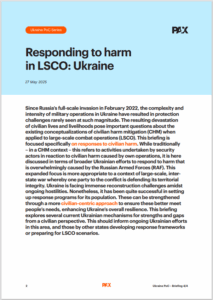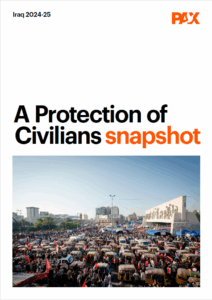Dutch transparency about civilian harm remains insufficient
In October 2019, it became known that Dutch military action in Hawija in June 2015 had caused the death of 70 civilians. Since then, the Dutch Ministry of Defense (MoD) has promised to review its transparency standards. Recently, Minister Bijleveld proposed the first changes in this area. While PAX is positive about some of the progress made, a number of concerns remain. Ultimately, the effectiveness of Dutch policy change will depend on strong engagement on issues like civilian harm investigation capacity, independent oversight, and better coalition agreements.
This Thursday October 8, a parliamentary debate takes place to discuss proposals by the Minister of Defense to improve transparent communication about Dutch military-caused civilian casualties. In a recent letter to Parliament, Minister Bijleveld committed to making it standard practice to notify the Defense Committee of the Dutch Parliament whenever Defense conducts an investigation into possible civilian casualties from its own military action. This certainly constitutes a step in the right direction, but more change is required to really improve Dutch practice in this area. In our latest policy brief, we identify three areas of particular concern:
1. Transparency decisions remain the Minister’s full responsibility
The Minister’s proposal to make information-sharing with Parliament about civilian casualty investigations standard practice is positive but comes with too many disclaimers attached to it. For one, the Minister remains in sole charge of deciding (1) whether she informs Parliament privately or publicly about investigations, (2) the timing of her notification, and (3) the level of detail to be shared. The criteria on which such decisions are based moreover remain unclear. Information-sharing occurs too much at the discretion of the Minister of Defense, which leads to a considerable risk that the Parliament and the public at large are informed too late or in too little detail about the negative effects of Dutch military action on civilians. Rather, the MoD should consider setting up an independent body to advise the Minister on decisions around information-sharing, using publicly available criteria.
2.Transparency depends on coalition agreements
Potentially more worrisome is that the Minister stands by her previous statements that whether information-sharing about investigations occurs in private or in public is dependent upon military coalition agreements. It has long been established that coalition structures disincentivize rather than encourage transparency by making it relatively easy for individual coalition members to evade accountability by hiding behind the collective. It is absolutely fundamental that transparency agreements become part of deliberations about participation in coalition operations. To show best practice itself and encourage it in others, the MoD should only consider participation in a new military coalition when transparency about civilian casualties from own military action can be guaranteed beforehand.
3. Transparency requires tracking and investigation capacity
It is important to recall that transparency about civilian casualty investigations is just one link in the chain of improving overall practice around civilian casualties from Dutch military action. In order to ensure investigations are possible, the military needs to carry out civilian harm tracking[1] activities, which require strong data collection and analysis capacities; there can only be investigations once there is reason to suspect civilian casualties. We moreover see that military investigations are often subject to considerable shortcomings. The International Coalition against ISIS has been criticized time and again for relying too much on military and air-only sources to investigate civilian harm claims.[2] For instance, aerial surveillance risks missing much harm because it does not ‘register’ people trapped or buried under the debris of collapsed buildings. As a result, the self-reported figures of Coalition-caused civilian casualties were much lower than those from independent monitoring organizations like Airwars. The MoD should therefore consider making it standard practice to consult non-military sources as well when conducting a civilian harm investigation.
It is encouraging that the Dutch military is undertaking its first steps to improve its practice with regard to transparent reporting about Dutch-caused civilian casualties. There is, however, still some way to go.
[1] For more information about the practice of civilian harm tracking, see our explainer.
[2] See in particular CIVIC (2020). In Search of Answers: U.S. Military Investigations and Civilian Harm; Airwars (2019). US Military assessments of civilian harm: Lessons learned from the international fight against ISIS.
About this news
Date of publication:
Oct 05, 2020
Author:
Erin Bijl
Extra:
Photo: Defense Secretary James N. Mattis meets with Netherlands Minster of Defense Ank Bijleveld at the Pentagon in Washington, D.C., April 11, 2018. (DoD photo by Tech Sgt. Vernon Young Jr.)

